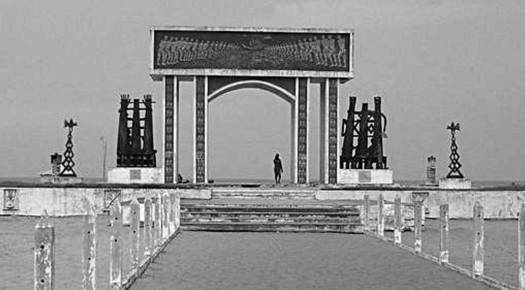
OUIDAH, BENIN - The Route des Esclaves, by which slaves were taken to the beach for trade, has numerous statues and monuments, including the Door of No Return, a memorial arch. Visitors from Africa, Europe, and the Americas continue to make it an important place to remember the human toll of African slavery. Ouidah is the spiritual capital of the Vodun religion and hosts an annual international Vodun conference. Vodouists believe in a distant and unknowable Supreme Creator, Bondye (derived from the French term Bon Dieu, meaning "good God"). The word "voodoo" comes from the West African word "vodun," meaning spirit. The universe is all one; each thing affects something else are the main philosophies of voodoo worshipers.
Erected in 1992 in memory of those packed on ships bound for the New World, it is a living reminder that the small Beninese coastal town of Ouidah once was the muster point for the black slave trade on the southern coast of West Africa. No-one knows the exact numbers of slaves who took this route through the centuries but that number is very big, about 5 or even 10 million. Ouidah is a place from which the cult of the invisible and of natural spirits was exported to Louisiana, Brazil and Haiti.
The first voodoo festival was launched in 1993 by President Nicephore Soglo, and that move has made Ouidah voodoo’s most famous place of pilgrimage for its 50 million followers worldwide. “Ouidah is a duty of memory,” said voodoo priest Erol Josue and added “It’s important to return to the ancestral land to accept oneself as a Caribbean.”
According to Gizirbtah — a young black American who changes her name whenever she travels to the home of her ancestors — “Voodoo is a way of life.” “Every day I do ablutions, purifications, prayers. But in the U.S. voodoo is frowned upon, people don’t understand,” she said.
“Every human has his inner ‘fa’ (a voodoo divinity), his other self. And we are all looking for our other self. Call that voodoo here or psychology in Europe,” said Vincent Harisdo, a choreographer of French, Beninese and Togolese heritage who is working on a dance project on voodoo. Music and dance are key elements to Voodoo ceremonies.
Gail Hardison, a 57-year-old American, had a DNA test several years ago and found out her ancestors came from northern Cameroon. This year she has brought her ancestral quest to Benin, pointing out that she is not a follower but respects voodoo as a religion. “Voodoo isn’t about dolls with pins in it,” she added. But despite the crowds who give a folklore feel to the festival, Hardison said she feels a “spiritual sadness” in Ouidah.
Looking at the Gate of No Return, where hundreds of visitors are crowded together trying to find some shade, she said: “I wish it could have been different for all the people who passed through here.”
“I feel them with me.”
Photo Credits: Wikimedia Commons
